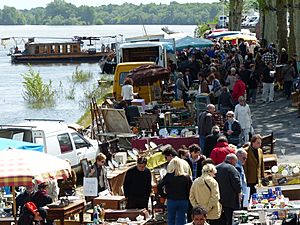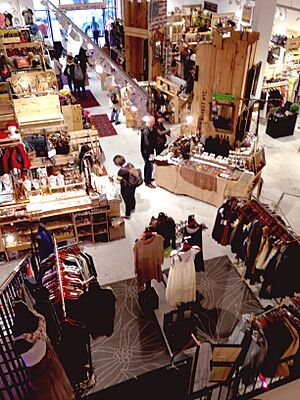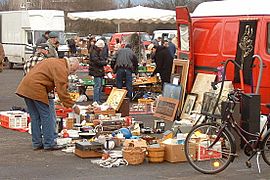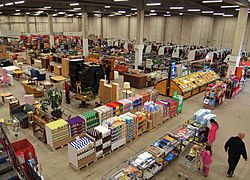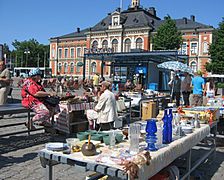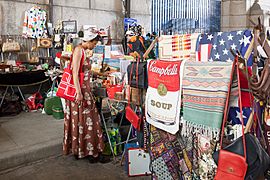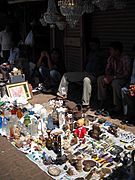Flea market facts for kids
A flea market (sometimes called a swap meet) is a type of market where people sell all sorts of things, especially second-hand items. It's like a big treasure hunt where you can find unique collectibles, antiques, vintage clothing, and other cool used goods.
Many flea markets happen only at certain times of the year, like in summer. But some are open all the time, with sellers who have their spots year-round. Buying second-hand items at flea markets is also a great way to help the environment!
Sellers at flea markets are different from regular street vendors. People come to the market just to find their stalls. Some sellers do it as a hobby, while others sell full-time to make a living. Good sellers know what's popular, like retro or vintage styles, and choose items their customers will love.
In the United States, the National Association of Flea Markets started in 1998. This group helps sellers, suppliers, and buyers connect and share tips.
Contents
Where Did the Name "Flea Market" Come From?
People have been selling used goods for thousands of years. But where did the name "flea market" come from? There are a few ideas!
One idea is that the name came from the Fly Market in New York City. This market was open in the 1700s near the East River in Manhattan. It was built on land that used to be a marsh with a small stream. By the early 1800s, the Fly Market was one of the city's main markets.
Another idea is that "flea market" comes from the French phrase marché aux puces. This literally means "market with fleas." People called it this because the used items sold there, like old furniture, supposedly had fleas!
One popular story about the French name comes from a magazine in 1998:
It is generally agreed that the term 'Flea Market' is a direct translation of the French marché aux puces. This was an outdoor market in Paris, France. It got its name from those annoying little bugs called fleas (Siphonaptera) that lived in the old furniture sold there.
A different story from a book about flea markets says:
During the time of Emperor Napoleon III, a city planner named Haussmann designed wide, straight streets for Paris. These plans made many second-hand dealers leave their old homes. Their alleys and slums were torn down. But these sellers were allowed to keep selling their goods just north of Paris, outside the old fort. The first stalls were set up around 1860. This gathering of sellers from the old slums was soon called "marché aux puces", or "flea market."
Different Names for Flea Markets
Flea markets have many different names around the world!
In the United States, an outdoor swap meet is the same as a flea market. But an indoor swap meet is more like a bazaar. It's a permanent indoor shopping center with fixed booths, open like a regular store.
Here are some other names:
- In Australian English, they are often called 'trash and treasure markets'.
- In the Philippines, the word is tianggê. This comes from a Mexican Spanish word.
- In India, they are known as gurjari or shrukawadi bazaar, or juna bazaar in Pune.
In the United Kingdom, if the market is in a field or car park, it's called a car boot sale. This is because sellers often sell items from the back of their car (the 'boot'). If it's indoors, like in a school hall, it's usually a jumble sale or a bring and buy sale.
In Quebec and France, they are often called Marché aux puces (flea market). In French-speaking parts of Belgium, they use brocante or vide-grenier.
In German, the most common word is "Flohmarkt," which also means "flea market." The same goes for Dutch "vlooienmarkt," Swedish "loppmarknad," and Finnish "kirpputori."
In areas of South Florida with many Cuban/Hispanic people, they are called [el] pulguero (the flea store). This comes from pulga, the Spanish word for fleas. In southern Andalusia, Spain, they are called "piojito," meaning "little louse."
In Chile, they can be called persas or mercados persa ("Persian market"). If they mostly sell fruits and vegetables, they are called ferias libres. In Argentina, they are often called "feria artesanal" (artisan's fair) or "feria americana" (American fair).
In Moroccan Darija, the word for "flea market" is جوطية juṭiyya. This name might come from French words meaning "to throw" or "throwable." Or it could be an older term from a word meaning "gathering of people." There was also an old village called "Juta" by the Sebou River that might have been a big market long ago.
Gallery
-
A vintage travel gear seller at Marché Dauphine, Saint-Ouen, Paris.
-
A flea market in Seppälä, Jyväskylä, Finland.
-
The Chor Bazaar in Mumbai, India.
-
A flea market in Leiden, Netherlands, in the late 1800s.
See also
 In Spanish: Mercadillo para niños
In Spanish: Mercadillo para niños
- Agora
- Braderie
- Car boot sale
- Charity shop
- Farmers' market
- Garage sale
- Hamfest
- Pasar malam
- White elephant sale


